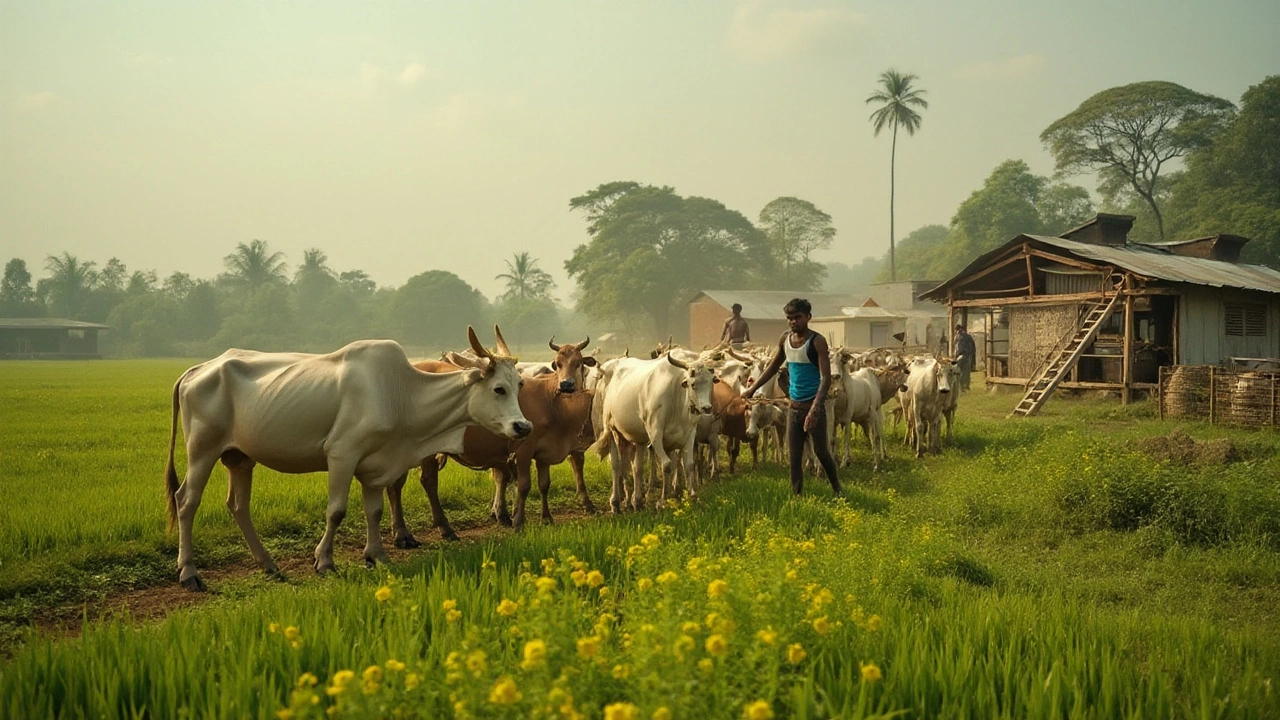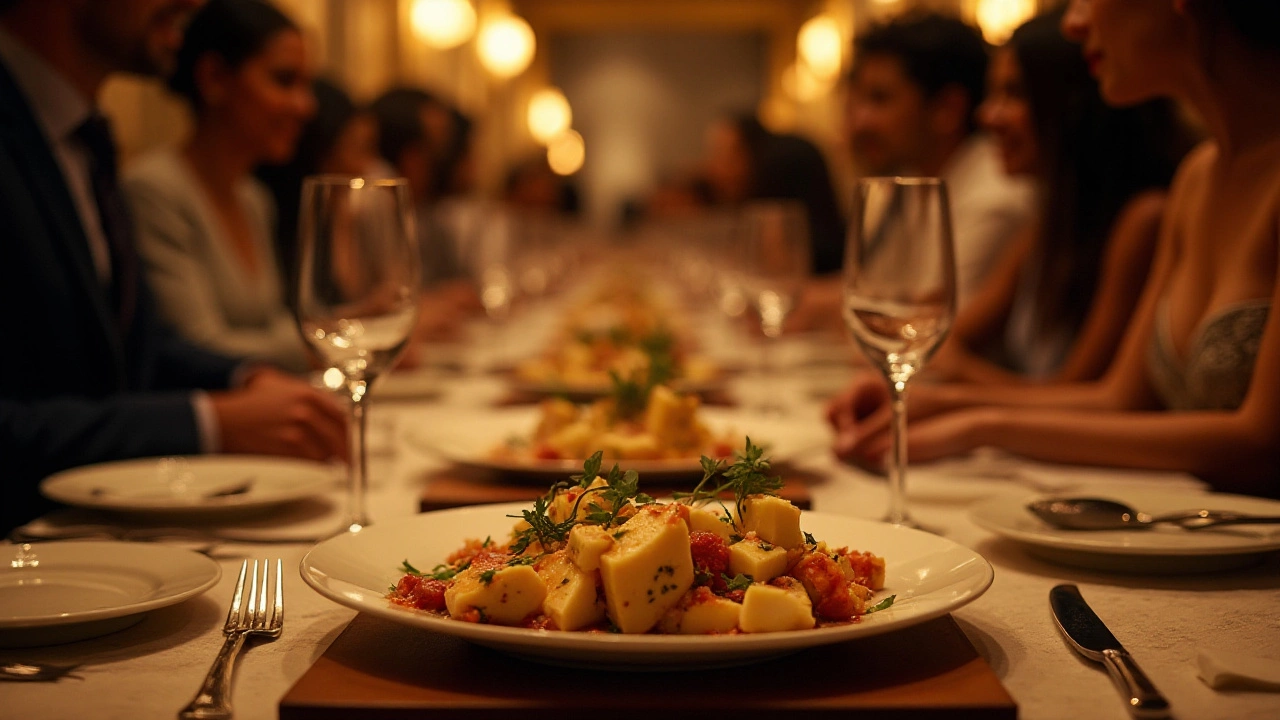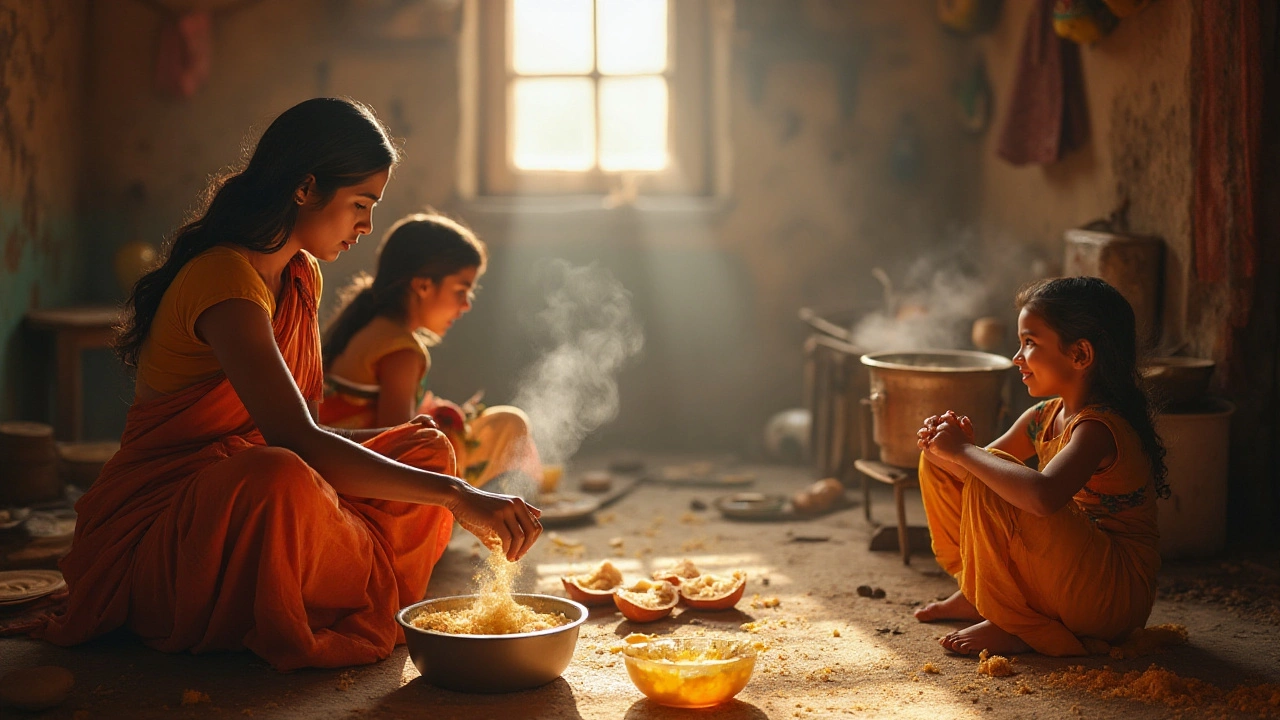Imagine planning a delicious meal rooted in rich culinary tradition, and at the heart of it lies that creamy block of paneer cheese. While this delectable ingredient is a staple in many cuisines, its price often makes would-be chefs pause. Have you ever wondered why paneer's price tag seems higher than expected?
The answer to this question weaves through a variety of reasons, from the careful process of crafting each block to the ever-shifting landscape of global dairy production. In this article, we'll delve into these aspects, exploring what makes this cheese both beloved and costly.
- The Essence of Paneer: A Brief Introduction
- The Intricate Art of Paneer-Making
- Economic Factors Behind the Price Tag
- Homemade Paneer: A Worthy Pursuit?
- Global Demand and Regional Variability
The Essence of Paneer: A Brief Introduction
Paneer, a soft and crumbly cheese, has long established itself as a cornerstone in the culinary practices of many cultures, notably throughout the Indian subcontinent. Its origins are as rich and layered as the cheese itself, believed to have been introduced by Persian and Afghan rulers during their invasions and subsequently embraced by Indian kitchens. Paneer, sometimes referred to as Indian cottage cheese, is unique because it doesn't melt when heated, allowing chefs to use it in a variety of dishes that require the cheese to maintain its structure and absorb the flavors around it.
Made by curdling milk with the introduction of fruit- or plant-based acids like lemon juice or vinegar, paneer's creation is a straightforward process that dates back centuries. Yet, it is this simplicity that contributes to its universal appeal. From a milk-based wonder to the deliciously tender cubes gracing many a curry, paneer's simplicity of production belies the skill required to perfect its texture and taste. Among its notable characteristics is its versatility; it can be grilled, fried, sautéed, or simply diced into salads, each method unlocking a new dimension of flavor in every bite.
The nutritional benefits of paneer further amplify its popularity. High in protein and calcium, it provides vital nutrients especially for vegetarians who rely on plant-based diets. Adept at replacing meat in numerous recipes, it underlines a gentle, compelling reason for its wide application. To truly appreciate paneer is to understand its role not just in gastronomic delight but also in supporting dietary needs. As famed chef Vikas Khanna once said,
"Paneer is not just an ingredient but a journey into the heart of home-style Indian cooking."
Yet, its humble appearance often conceals its crucial importance in many kitchens. It's a cheese that echoes the socio-cultural aspects of the regions it is loved and served. From communal feasts during festivals to everyday meals shared among families, paneer transcends its culinary identity to become a symbol of hospitality and warmth. This unassuming cheese connects countries, stories, and generations through its hearty presence on plates around the world.
In recent years, increasing global awareness and interest in vegetarian and vegan lifestyles have brought paneer into the spotlight internationally, sparking curiosity and admiration well beyond its traditional borders. This growing allure places paneer alongside some of the most sought-after cheese varieties globally, carving its niche in the diverse and expansive world of cheese production. Its mild yet satisfying flavor profile makes it an inviting option for adventurous culinary explorers seeking to incorporate a touch of the exotic into their regular diets.
The Intricate Art of Paneer-Making
Making paneer cheese is more than just a kitchen task; it is truly an art form appreciated by chefs and home cooks alike. The process begins with selecting the right type of milk. Full-fat milk is the recommended choice as it yields a rich and creamy paneer. The first step in this cheese-making endeavor involves heating the milk to a gentle boil, being cautious not to scorch it, as this would compromise the cheese’s flavor and texture. Once heated, the milk is gradually curdled with the introduction of an acid like lemon juice or vinegar. Watching the transformation as the milk starts to coagulate is nothing short of magical, turning from a liquid into those tender curds.
The skillful balancing act lies in knowing just the right moment to stop the acid addition, ensuring that the curds are neither too soft nor too firm. After the curds have formed, they are carefully strained through a cheesecloth, separating them from the whey. At this juncture, the secret to achieving the perfect paneer lies in applying the right amount of pressure. Wrapping the curds snugly in the cloth and placing a weight on top for a few hours decides the paneer’s firmness. This process may sound straightforward, but slight missteps can lead to crumbled or overly chewy cheese.
According to renowned culinary writer Madhur Jaffrey, "Paneer-making requires a gentle yet assured touch. It's about witnessing the transformation of humble milk into something extraordinary."
Paneer is more about technique than just following a recipe. The soul of paneer lies in understanding its chemistry.These thoughtful observations capture the spirit of paneer-making that has been passed down through generations. This traditional method highlights the importance of patience and attention to detail in the kitchen.
Once the paneer is formed, it is ready to be cubed and used in various dishes. From a simple curry to intricate desserts, this versatile cheese can be flavored in countless ways. However, achieving the perfect texture that holds up in cooking yet melts softly in the mouth is often why store-bought paneer comes with a premium price. For those inclined to try, homemade paneer offers a rewarding challenge that brings a deep sense of satisfaction, boasting freshness that is hard to match. Understanding these steps uncovers why economic investments and skill play pivotal roles in determining the cost of quality paneer on the market.

Economic Factors Behind the Price Tag
When you consider the price of paneer cheese, you're essentially diving into a web of economic intricacies that affect both the production and pricing of this beloved dairy product. First, it's important to grasp the basic principle that paneer consists predominantly of milk, which is an expensive raw material compared to processed ingredients. To produce one kilogram of paneer, you might need around ten liters of milk, which partially explains its cost. In regions where dairy farming is limited by geography or climate, importing milk or dairy products can add to expenses. This dependency on high-quality milk, which must meet stringent health and safety standards, inevitably increases the cost of producing paneer.
The supply chain also plays a pivotal role. Paneer does not travel well over long distances because it's highly perishable, unlike its aged cheese relatives that benefit from a broader distribution network due to their lengthy shelf life. Hence, many businesses face logistical challenges resulting in higher expenses deeper into their distribution cycles. Added to this, refrigerated transport and storage conditions are necessary to maintain its quality, increasing the expenditure for manufacturers and, ultimately, for consumers. These costs are frequently passed on, making it more expensive when it reaches store shelves.
Homemade paneer, while a popular alternative, isn't necessarily cheaper when considering opportunity costs, time, and effort. However, the price of store-bought paneer can also be seen through the lens of supply and demand. With increasing popularity due to the expansion of Indian and vegetarian cuisines around the world, more people are buying paneer. Higher demand naturally results in a rise in prices, as not every market can supply it efficiently. A 2023 study reported that the demand for Indian dairy products in international markets had grown by 40%, reflecting an ever-growing love for diverse culinary flavors and vegetarian options, which are dependent on quality paneer.
"Supply and demand in emerging markets have a significant impact on the costs of milk-derived products like paneer," stated Frances Lappé, a noted food systems analyst. "As more individuals gravitate towards these foods for health and ethical reasons, costs will likely reflect these trends."
Furthermore, government policies and tariffs often influence paneer's price. In some countries, dairy is heavily regulated, with subsidies and tariffs impacting cross-border trade. For example, if tariffs are high on imported milk in a country that doesn't produce enough locally, paneer's price can reflect that additional cost. Finally, the labor involved in making paneer, although not mechanized to the extent of other cheese productions, requires a skillful touch to ensure the right texture and taste. These artisanship aspects can't always be automated, adding a labor cost that factors into the final retail price.
Homemade Paneer: A Worthy Pursuit?
For many culinary enthusiasts, the allure of making homemade paneer lies not just in the cost savings but in the sheer joy of creating something fresh and delicious from scratch. Making paneer at home is a fascinating process that has been a beloved tradition across many cultures. It involves just a few simple ingredients: milk and an acid, such as lemon juice or vinegar. Yet, the simplicity of elements belies the rich, complex flavors they produce. Many find this pursuit rewarding as they explore how the creamy texture and subtle taste of their homemade version often surpasses what can be bought at the store. An important part of successful homemade paneer-making is choosing high-quality, full-fat milk. The richness of the milk directly impacts the flavor and texture of the final product. This is why many seasoned paneer-makers opt for organic or local dairy sources. This choice not only benefits local economies but also boosts the quality of the cheese due to the little-to-no additives present.
The process itself requires some patience. Heating the milk gently to just below boiling point can take time, but it's essential to avoid scalding, which could alter the taste. Once the acid is added, the magic begins: the milk separates into curds and whey, unveiling the cheese foundation. This natural splitting is a gentle reminder of the chemistry occurring in your pot, a dance of temperatures and reactions yielding something extraordinary.
"Patience is key to homemade paneer," says Anand Patel, a renowned Indian chef, "The smoother the process, the creamier the cheese, making each bite a testament to your dedication and care."
After draining and pressing the curds into a firm block, many find their homemade paneer softer and more crumbly than commercial varieties. This texture, coupled with a significantly fresher flavor, often elevates home-cooked dishes like palak paneer or paneer tikka to a new level. One could argue that this, in itself, is worth the effort for anyone yearning for authenticity. Besides, there lies the hidden benefit of customization. Homemade paneer opens the door to flavor experimentation; incorporating herbs and spices like black pepper or cumin directly into the curds can infuse your paneer with unique twists. The satisfaction derived from this culinary exploration is doubled by the appreciation of family and friends who savor your creation.
Yet, it is important to recognize the challenges along with the rewards. There is a learning curve, and initial attempts might not always result in perfectly textured cheese. New experiences often come with moments of trial and error. Over time, though, practice leads to precision. For those eager to take on the challenge, the internet offers a plethora of video tutorials and community recipe forums to guide and support burgeoning cheese makers. Making paneer cheese at home can also contribute to a more sustainable lifestyle. It allows you to avoid plastic waste often associated with store-bought cheese packaging, especially if you buy your milk in reusable containers. Homemade dairy products can fit neatly into a broader eco-conscious lifestyle that many try to pursue.
In light of all these aspects, whether homemade paneer truly is a worthy pursuit eventually circles back to the individual. It's a dance of perseverance, creativity, cultural exploration, and enjoyment. Each attempt can be its gift, a reminder of heritage, the warmth of tradition, and the delicious potential of simple ingredients. Ultimately, deciding to embark on this culinary adventure depends on what one seeks in the kitchen and beyond. Yet, for those who dare, the rewards are as rich as the paneer they lovingly create.

Global Demand and Regional Variability
Paneer cheese isn't just a culinary delight; it's a cultural symbol found in kitchens from India to North America. This cheese plays a crucial role in traditional dishes, making its global demand consistently high. Influenced by a growing trend towards vegetarian diets worldwide, more people are turning towards plant-based meals, where paneer cheese often steals the spotlight. There are recipes across continents celebrating its mild flavor and firm texture. This has positioned paneer as a sought-after item not just in households but also in high-end restaurants that aim to provide authentic cultural experiences.
The demand varies significantly by region due to culinary practices and local preferences. In India, for example, paneer is a menu mainstay. Its popularity remains unrivaled owing to both tradition and taste. However, Europe and America are catching up as the cheese gains attention in wellness circles for being a good protein source while keeping dietary restrictions in check. Yet, supply chains remain strained under this rising demand, often attributed to the limited dairy production capabilities outside of paneer's origin countries. This can create a pricing variability that's evident when comparing costs between local street shops in Delhi and artisanal cheese counters in London.
This variance stems from several factors. Import duties and regulations can inflate prices immediately, but it's not just the legalities. Dairy production itself has regional complexities; some countries face challenges like climate impacts on dairy production or restricted access to necessary resources like feed. These elements can directly influence the availability and cost of high-quality milk, the primary ingredient for paneer. Beyond these logistics, global economic fluctuations, such as rising fuel prices or labor costs, add layers of complexity to the already intricate equation of paneer's pricing in different parts of the globe.
Interestingly, paneer has become a test case for how specialty foods adapt in a global market. As demand grows, some innovative solutions have emerged. For instance, self-sustaining dairy farms focusing on humane animal husbandry have started proliferating. Such farms reduce dependency on imports, allowing local production to offset unpredictable costs. This approach not only supports local economies but ensures that consumers in diverse locations can enjoy paneer without exorbitant markup. A report from Agri-Food Economics suggests that "regions that localize illustrate an encouraging trend where consumers access affordable pricing, fostering a widespread appreciation for paneer's culinary versatility."
Not to be overlooked is the role of cultural exchange in influencing paneer's popularity. Cooking shows and online culinary communities have invited chefs from around the world to explore paneer's potential, inspiring dishes far removed from its traditional uses. This exploration broadens the cheese's appeal, ensuring that curiosity continually drives demand even among those previously unfamiliar with it. In a world connected by digital and air travel, paneer's adaptability makes it a cherished component of fusion cuisines and a beloved ingredient across continents.
